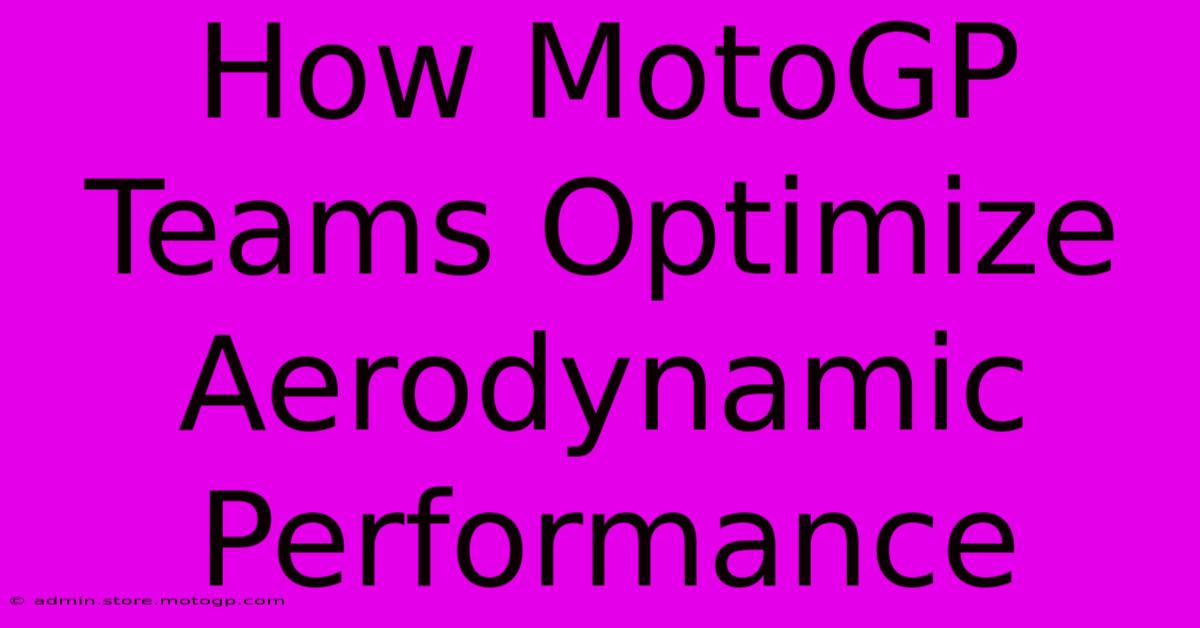How MotoGP Teams Optimize Aerodynamic Performance

Table of Contents
How MotoGP Teams Optimize Aerodynamic Performance
MotoGP, the pinnacle of motorcycle road racing, is a relentless pursuit of speed and efficiency. Every millisecond shaved off lap times can mean the difference between victory and defeat. A crucial element in this high-stakes competition is aerodynamic performance. Top teams dedicate immense resources to optimizing their bikes' aerodynamics, pushing the boundaries of what's possible. This article delves into the sophisticated strategies and technologies employed by MotoGP teams to gain that critical edge.
Understanding Aerodynamic Principles in MotoGP
Before diving into the optimization techniques, it's essential to grasp the fundamental aerodynamic forces at play. In MotoGP, the primary focus is on minimizing drag and maximizing downforce.
- Drag: This resistive force opposes the bike's forward motion, slowing it down. Reducing drag is crucial for achieving higher top speeds on straights.
- Downforce: This force pushes the bike downwards, increasing its grip and stability, particularly through corners. More downforce allows riders to lean into turns at higher speeds.
The balance between drag and downforce is crucial. While increased downforce improves cornering, excessive drag can negate the benefits. The challenge lies in finding the optimal balance for different track characteristics and racing conditions.
Key Aerodynamic Components
Several key components contribute significantly to a MotoGP bike's aerodynamic performance:
- Fairings: The bodywork of the motorcycle, including the front fairing, side fairings, and tail section, are meticulously designed to manage airflow. The shape and design are constantly refined through Computational Fluid Dynamics (CFD) simulations and wind tunnel testing.
- Wings: Winglets and other aerodynamic appendages, often located on the fairing and swingarm, generate downforce. Their design and placement are critical, as poorly designed wings can actually increase drag.
- Underbody: The area beneath the bike is also crucial. Smooth surfaces and carefully designed airflow channels beneath the motorcycle contribute significantly to minimizing drag and generating downforce.
Optimization Strategies Employed by MotoGP Teams
MotoGP teams employ a multi-faceted approach to optimize their bikes' aerodynamic performance. This involves a combination of advanced technologies, meticulous analysis, and continuous refinement.
1. Computational Fluid Dynamics (CFD) Simulation
CFD is a powerful tool used to model and analyze airflow around the motorcycle. Sophisticated software simulates various design iterations, allowing engineers to evaluate their impact on drag and downforce before physical prototypes are built. This significantly reduces development time and cost.
2. Wind Tunnel Testing
While CFD provides valuable insights, wind tunnel testing is crucial for validating the simulations and refining the designs. Teams meticulously test various components and configurations in controlled environments, meticulously measuring aerodynamic forces and airflow patterns. This allows for fine-tuning and optimization based on real-world data.
3. Data Acquisition and Analysis
During testing and races, teams collect vast amounts of data related to aerodynamic performance. Sensors on the motorcycle measure various parameters, providing valuable feedback for iterative improvements. Sophisticated data analysis tools are used to identify areas for optimization and to correlate aerodynamic performance with rider feedback.
4. Rider Feedback
Rider feedback is invaluable in the aerodynamic optimization process. Experienced MotoGP riders can provide crucial insights into how the bike handles in different conditions and offer feedback on the effects of various aerodynamic modifications.
5. Material Selection
The materials used in the construction of aerodynamic components also impact performance. Lightweight yet strong materials are crucial for minimizing weight and maximizing aerodynamic efficiency.
The Constant Evolution of Aerodynamics in MotoGP
The pursuit of aerodynamic optimization in MotoGP is a continuous process. Teams are constantly experimenting with new designs and technologies, pushing the boundaries of what's possible. The development is a dynamic interplay between theoretical understanding, advanced technology, and practical testing. The quest for that crucial advantage in aerodynamic performance continues to drive innovation and competitiveness in the electrifying world of MotoGP.

Thank you for visiting our website wich cover about How MotoGP Teams Optimize Aerodynamic Performance. We hope the information provided has been useful to you. Feel free to contact us if you have any questions or need further assistance. See you next time and dont miss to bookmark.
Featured Posts
-
The Aero Question Is It Ruining Moto Gp
Feb 21, 2025
-
Get Closer To The Action F1 Shuttles
Feb 21, 2025
-
Cota Parking Map Your Comprehensive Guide
Feb 21, 2025
-
Cota Parking Find Your Zone
Feb 21, 2025
-
Famous Motorcycle Riders Their Signature Styles
Feb 21, 2025
